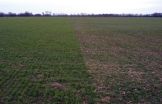(Press-News.org) WEST LAFAYETTE, Ind. - Many of the genes that allow wheat to ward off Hessian flies are no longer effective in the southeastern United States, and care should be taken to ensure that resistance genes that so far haven't been utilized in commercial wheat lines are used prudently, according to U.S. Department of Agriculture and Purdue University scientists.
An analysis of wheat lines carrying resistance genes from dozens of locations throughout the Southeast showed that some give little or no resistance to the Hessian fly, a major pest of wheat that can cause millions of dollars in damage to wheat crops each year. Others, even those considered the most effective, are allowing wheat to become susceptible to the fly larvae, which feed on and kill the plants.
Wheat resistance genes recognize avirulent Hessian flies and activate a defense response that kills the fly larvae attacking the plant. However, this leads to strains of the fly that can overcome resistant wheat, much like insects becoming resistant to pesticides.
"The number of genes available to protect wheat is limited. There really aren't that many," said Richard Shukle, a research scientist with the USDA Agricultural Research Service Crop Production and Pest Control Research Unit and Purdue adjunct associate professor of entomology. "In the Southeast, having multiple generations of Hessian fly each year enhances the ability of these flies to overcome wheat's resistance."
Sue Cambron, a USDA Agricultural Research Service research support scientist, received Hessian flies from 20 locations in Alabama, Georgia, North Carolina, South Carolina and Louisiana and used them to infest 21 varieties of wheat that each contained different resistance genes, most of which have been deployed in commercial wheat, and a few that haven't yet. While the study did not include all of the 33 named resistance genes, it did show that only five of the 21 genes evaluated would provide effective resistance to flies in the Southeast, and none was effective in all the Southeast locations.
"Even some of the newer genes that haven't been deployed in cultivars weren't too effective," Cambron said.
That's because flies have likely interacted with, and adapted to, those genes already, said Brandi Schemerhorn, a USDA-ARS entomologist and Purdue assistant professor of entomology. She said it's possible that some of the genes were introduced to flies unintentionally in plots where wheat cultivars with those genes were being tested for suitability to Southeast climates. The resistance genes also could have come from other plants, such as rye, and the flies may already have started to overcome those genes.
Schemerhorn said she suspects a certain number of flies in any population have the ability to overcome any wheat resistance gene, which defends against the flies' ability to feed on the plant and starves the insect larvae. When a resistance gene kills off some of the flies, the survivors breed and eventually establish a population that renders the gene ineffective.
"We're creating a system in which the fly is becoming more virulent," Schemerhorn said. "What we have to do is slow down that adaptation or virulence."
Shukle and Schemerhorn suggest stacking genes in a wheat cultivar. There are only a few genes that haven't been deployed, and they believe combining two of those would be the best option.
"With a small number of identified resistance genes, we can't afford to release wheat lines with only one resistance gene," Shukle said. "If you deploy two different resistance genes, it's unlikely that a population of flies could overcome both of them."
Schemerhorn is working to combine two of the unreleased genes for testing with Hessian fly populations.
INFORMATION:
The USDA funded the research. Shukle, Schemerhorn and Cambron collaborated with David Buntin, a University of Georgia professor of entomology; Randy Weisz, a North Carolina State associate professor of crop science and small grains specialist; Kathy Flanders, an Auburn University associate professor of entomology; and Jeff Holland, a Purdue associate professor of entomology. Their findings were published in the Journal of Economic Entomology.
Writer: Brian Wallheimer, 765-496-2050, bwallhei@purdue.edu
Sources: Richard Shukle, 765-494-6351, shukle@purdue.edu
Brandi Schemerhorn, 765-494-7494, bschemer@purdue.edu
Sue Cambron, 765-494-5870, cambron@purdue.edu
PHOTO CAPTION:
Wheat with resistance genes (left) shows little damage from Hessian flies, while a non-resistant variety (right) has been largely destroyed. (Photo courtesy of Dr. Michael Boyd, University of Missouri)
A publication-quality photo is available at http://news.uns.purdue.edu/images/2010/hessian-damage.jpg
PHOTO CAPTION:
Two Hessian flies on a piece of wheat. (Purdue Agricultural Communication photo/Tom Campbell)
A publication-quality photo is available at http://news.uns.purdue.edu/images/2010/hessian-flies.jpg
Abstract on the research in this release is available at: http://www.purdue.edu/newsroom/research/2011/110124ShukleGenes.html
Wheat resistance genes failing, new approach needed to stop flies
2011-01-26
ELSE PRESS RELEASES FROM THIS DATE:
Conversion of brain tumor cells into blood vessels thwarts treatment efforts
2011-01-26
LA JOLLA, CA--Glioblastoma, the most common and lethal form of brain cancer and the disease that killed Massachusetts Senator Ted Kennedy, resists nearly all treatment efforts, even when attacked simultaneously on several fronts. One explanation can be found in the tumor cells' unexpected flexibility, discovered researchers at the Salk Institute for Biological Studies.
When faced with a life-threatening oxygen shortage, glioblastoma cells can shift gears and morph into blood vessels to ensure the continued supply of nutrients, reports a team led by Inder Verma, Ph.D., ...
Purdue team creates 'engineered organ' model for breast cancer research
2011-01-26
WEST LAFAYETTE, Ind. - Purdue University researchers have reproduced portions of the female breast in a tiny slide-sized model dubbed "breast on-a-chip" that will be used to test nanomedical approaches for the detection and treatment of breast cancer.
The model mimics the branching mammary duct system, where most breast cancers begin, and will serve as an "engineered organ" to study the use of nanoparticles to detect and target tumor cells within the ducts.
Sophie Lelièvre, associate professor of basic medical sciences in the School of Veterinary Medicine, and ...
Blue crab research may help Chesapeake Bay watermen improve soft shell harvest
2011-01-26
Baltimore, Md. (January 24, 2011) – A research effort designed to prevent the introduction of viruses to blue crabs in a research hatchery could end up helping Chesapeake Bay watermen improve their bottom line by reducing the number of soft shell crabs perishing before reaching the market. The findings, published in the journal Diseases of Aquatic Organisms, shows that the transmission of a crab-specific virus in diseased and dying crabs likely occurs after the pre-molt (or 'peeler') crabs are removed from the wild and placed in soft-shell production facilities.
Crab ...
Loyola physician helps develop national guidelines for osteoporosis
2011-01-26
MAYWOOD, Ill. -- The American Association of Clinical Endocrinologists (AACE) has released new medical guidelines for the diagnosis and treatment of postmenopausal osteoporosis. Loyola physician Pauline Camacho, MD, was part of a committee that developed the guidelines to manage this major public health issue.
These recommendations were developed to reduce the risk of osteoporosis-related fractures and improve the quality of life for patients. They explain new treatment options and suggest the use of the FRAX tool (a fracture risk assessment tool developed by the World ...
GRIN plasmonics
2011-01-26
They said it could be done and now they've done it. What's more, they did it with a GRIN. A team of researchers with the U.S. Department of Energy (DOE)'s Lawrence Berkeley National Laboratory (Berkeley Lab) and the University of California, Berkeley, have carried out the first experimental demonstration of GRIN – for gradient index – plasmonics, a hybrid technology that opens the door to a wide range of exotic optics, including superfast computers based on light rather than electronic signals, ultra-powerful optical microscopes able to resolve DNA molecules with visible ...
Women in Congress outperform men on some measures
2011-01-26
Congresswomen consistently outperform their male counterparts on several measures of job performance, according to a recent study by University of Chicago scholar Christopher Berry.
The research comes as the 112th Congress is sworn in this month with 89 women, the first decline in female representation since 1978. The study authors argue that because women face difficult odds in reaching Congress – women account for fewer than one in six representatives – the ones who succeed are more capable on average than their male colleagues.
Women in Congress deliver more federal ...
Legal restrictions compromise effectiveness of advance directives
2011-01-26
Current legal restrictions significantly compromise the clinical effectiveness of advance directives, according to a study by researchers at the University of California, San Francisco.
Advance directives allow patients to designate health care decision-makers and specify health care preferences for future medical needs. However, "the legal requirements and restrictions necessary to execute a legally valid directive prohibit many individuals from effectively documenting their end-of-life wishes," said lead author Lesley S. Castillo, BA, a geriatrics research assistant ...
Neurologists predict more cases of stroke, dementia, Parkinson's disease and epilepsy
2011-01-26
MAYWOOD, Ill. -- As the population ages, neurologists will be challenged by a growing population of patients with stroke, dementia, Parkinson's disease and epilepsy.
The expected increase in these and other age-related neurologic disorders is among the trends that Loyola University Health System neurologists Dr. José Biller and Dr. Michael J. Schneck describe in a January, 2011, article in the journal Frontiers in Neurology.
In the past, treatment options were limited for patients with neurological disorders. "Colloquially, the neurologist would 'diagnose and adios,'" ...
Preschool kids know what they like: Salt, sugar and fat
2011-01-26
EUGENE, Ore. -- (Jan. 25, 2011) -- A child's taste preferences begin at home and most often involve salt, sugar and fat. And, researchers say, young kids learn quickly what brands deliver the goods.
In a study of preschoolers ages 3 to 5, involving two separate experiments, researchers found that salt, sugar and fat are what kids most prefer -- and that these children already could equate their taste preferences to brand-name fast-food and soda products.
In a world where salt, sugar and fat have been repeatedly linked to obesity, waiting for children to begin school ...
Biologists' favorite worm gets viruses
2011-01-26
A workhorse of modern biology is sick, and scientists couldn't be happier.
Researchers at Washington University School of Medicine in St. Louis, the Jacques Monod Institute in France and Cambridge University have found that the nematode C. elegans, a millimeter-long worm used extensively for decades to study many aspects of biology, gets naturally occurring viral infections.
The discovery means C. elegans is likely to help scientists study the way viruses and their hosts interact.
"We can easily disable any of C. elegans' genes, confront the worm with a virus and ...





